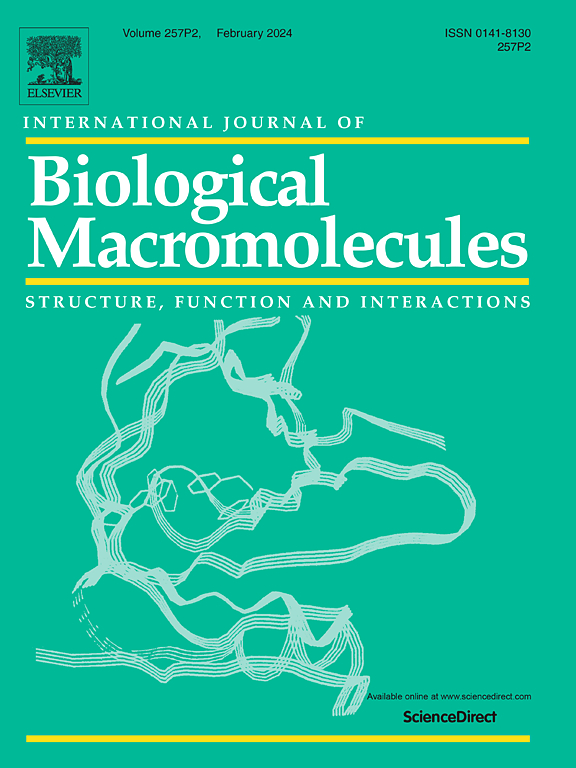Edible mushroom polysaccharides: Structural characteristics, chemical modification strategies, and structure-activity relationship: A review
IF 7.7
1区 化学
Q1 BIOCHEMISTRY & MOLECULAR BIOLOGY
International Journal of Biological Macromolecules
Pub Date : 2025-07-10
DOI:10.1016/j.ijbiomac.2025.145888
引用次数: 0
Abstract
Edible fungal polysaccharides (EFPs) are emerging bioactive macromolecules, with 4545 articles published from 2014 to 2024 and over 118,000 citations. However, their structure–activity relationship (SAR) remains inadequately defined, and the effects of extraction and chemical modification require systematic evaluation. This review summarizes the structural features of EFPs—including α−/β-glucans, heteroglucans, galactans, and mannans—and explores how molecular weight (1.27–5420 kDa), monosaccharide composition, glycosidic linkage patterns, branching, and spatial conformation influence bioactivity. β-(1 → 3)-glucans with β-(1 → 6) branches and triple-helix conformations show strong immunomodulatory effects, while low-molecular-weight fractions (<50 kDa) enriched in uronic acids exhibit enhanced antioxidant activity. Medium-weight polysaccharides (100–500 kDa) act via dectin-1 and Toll-like receptors. Chemical modifications—such as sulfation (DS 1.5–2.0), acetylation, carboxymethylation, selenylation, and phosphorylation—further enhance bioactivities. For example, selenylated EFPs improved zeta potential by 69.12 % and exhibited dose-dependent antitumor effects, while phosphorylated derivatives showed enhanced anti-inflammatory activity. The review highlights critical challenges in extraction standardization and quality control. Integration of advanced analytical techniques (e.g., HPSEC-MALLS, 2D-NMR, AFM) enables atomic-level characterization. Future directions include site-specific modification, machine learning-driven SAR prediction, and sustainable design strategies. This work provides a mechanistic foundation for the rational development of EFP-based therapeutics targeting immunity, metabolism, and gut microbiota.

食用菌多糖:结构特征、化学改性策略及构效关系综述
食用菌多糖(EFPs)是新兴的生物活性大分子,2014年至2024年共发表4545篇论文,被引用超过11.8万次。然而,它们的构效关系(SAR)仍不明确,提取和化学改性的效果需要系统评价。本文综述了efps的结构特征,包括α−/β-葡聚糖、杂葡聚糖、半乳聚糖和甘露聚糖,并探讨了分子量(1.27-5420 kDa)、单糖组成、糖苷连锁模式、分支和空间构象对生物活性的影响。具有β-(1→6)支链和三螺旋结构的β-(1→3)-葡聚糖具有较强的免疫调节作用,而富含醛酸的低分子量组分(<50 kDa)具有较强的抗氧化活性。中等重量的多糖(100-500 kDa)通过dectin-1和toll样受体起作用。化学修饰——如磺化(DS 1.5-2.0)、乙酰化、羧甲基化、硒化和磷酸化——进一步增强了生物活性。例如,硒化的EFPs使zeta电位提高了69.12%,并表现出剂量依赖性的抗肿瘤作用,而磷酸化的EFPs则表现出增强的抗炎活性。综述强调了萃取标准化和质量控制方面的关键挑战。集成先进的分析技术(例如,HPSEC-MALLS, 2D-NMR, AFM)使原子级表征成为可能。未来的发展方向包括特定地点的修改、机器学习驱动的SAR预测和可持续设计策略。这项工作为合理开发以efp为基础的靶向免疫、代谢和肠道微生物群的治疗方法提供了机制基础。
本文章由计算机程序翻译,如有差异,请以英文原文为准。
求助全文
约1分钟内获得全文
求助全文
来源期刊
CiteScore
13.70
自引率
9.80%
发文量
2728
审稿时长
64 days
期刊介绍:
The International Journal of Biological Macromolecules is a well-established international journal dedicated to research on the chemical and biological aspects of natural macromolecules. Focusing on proteins, macromolecular carbohydrates, glycoproteins, proteoglycans, lignins, biological poly-acids, and nucleic acids, the journal presents the latest findings in molecular structure, properties, biological activities, interactions, modifications, and functional properties. Papers must offer new and novel insights, encompassing related model systems, structural conformational studies, theoretical developments, and analytical techniques. Each paper is required to primarily focus on at least one named biological macromolecule, reflected in the title, abstract, and text.

 求助内容:
求助内容: 应助结果提醒方式:
应助结果提醒方式:


